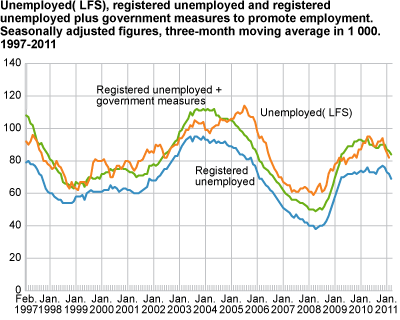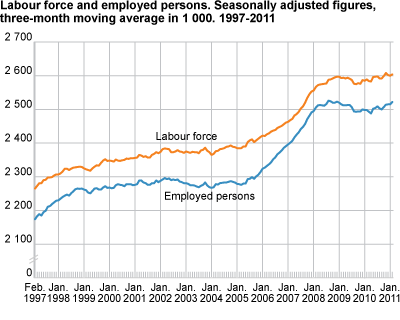Content
Published:
This is an archived release.
Decrease in labour force participation
From the 1st quarter of 2010 to the 1st quarter of 2011 the labour force participation decreased by 0.9 percentage points, ending at 70.9 per cent. The decrease was among men.
Seasonally-adjusted figures: continued decrease in unemploymentA total of 3.1 per cent of the labour force was unemployed in February 2011; a decrease of 0.5 percentage points since November 2010. Adjustments for seasonal variations allow for the analysis of current developments in the labour market, and serve as an alternative to comparisons with the corresponding quarter in the previous year. Seasonally-adjusted figures are presented in a separate article . |
The decrease in the labour force participation is due to the heavy population growth of 62 000 persons; a growth that does not correspond to the development of the labour participation rate. From the 1st quarter of 2010 to the 1st quarter of 2011 the labour force increased by 14 000 people. The decrease in the labour force participation rate was especially high among the youngest and among men between 55-66 years of age.
The population growth and absence of growth in the labour force participation rate is reflected in an increase of 14 000 persons having education as their main activity, while 24 000 more persons were early retired/disabled or retired. These are groups that are considered to be outside the labour force.
|
The labour force is the sum of employed and unemployed between 15-74 years of age. From the 1st quarter of 2010 to the 1st quarter of 2011 the LFS shows that employment rose by about 25 000 persons and unemployment fell by 11 000 persons. This gives an increase in the labour force of 14 000 persons. Because of a population growth of 62 000 persons in the same period, there is nevertheless a decrease in the labour force participation rate. The coherence between the conceptsUnemployed + Employed = Labour force Labour force + Outside the labour force = Population |
Increase in employment within human health and social work activities
From the 1st quarter of 2010 to the 1st quarter of 2011, employment rose by 25 000 persons. Human health and social work activities had an increase of 28 000 persons. There were only small changes in the other major industries.
In the 1st quarter of 2011 there were 173 000 persons on temporary contracts. This amounts to 7.4 per cent of the total employment. The use of temporary contracts is most frequent within education and human and health social work, with 13 and 11 per cent of the employees respectively.
Decrease in unemployment
Between the 1st quarter of 2010 and the 1st quarter of 2011 the number of unemployed increased by 11 000 persons. The decrease was among people who have been unemployed for less than three months. The share of long-term unemployed has risen from 32 to 34 per cent. Long-term unemployed are people who have been out of work for more than 26 weeks.
There was a total of 68 000 underemployed persons in the 1st quarter of 2011; 5 000 more than the corresponding quarter the year before. Underemployment is employees with part-time contractual working hours who have tried to find more work. Together, the groups of underemployed and unemployed wanting work corresponds to 96 000 full-time equivalents in the 1st quarter of 2011; down 8 000 from the year before. The decrease is due to less unemployment.
Tables:
- Table 1. Population aged 15-74 by labour force status (LFS) and sex 1000
- Table 2. Population aged 15-74 by labour force status (LFS) and sex. Changes from the same period inthe previous year. 1000
- Table 3. Population aged 15-74 by labour force status (LFS) and sex. Per cent
- Table 4. Persons in the labour force and employed persons aged 15-74, by age and sex (LFS). 1000
- Table 5. Persons in the labour force and employed persons aged 15-74, by age and sex (LFS). In per cent of the population
- Table 6. Persons aged 15-74, employed persons by contractual/usual working hours per week and unemployedpersons by age and sex (LFS). 1000
- Table 7. Persons in the labour force aged 15-74 by age and sex (LFS). 1000
- Table 8. Persons in the labour force aged 15-74 by age and sex (LFS). As per cent of all in each group
- Table 9. Employed persons aged 15-74 by sex and contractual/usual working hours per week (LFS). 1 000
- Table 10. Population aged 15-74, by main activity, part-time employment and age (LFS). 1 000
- Table 11. Employed persons aged 15-74 by major industry division (LFS). 1 000
- Table 12. Average number of man-weeks worked (37,5 hours), by industry division (LFS). 1 000
- Table 13. Employed persons aged 15-74 and average number of man-weeks worked (a 37.5 hours)by sex and status. 1000. Actual working hours, by sex and status. Hours perweek.
- Table 14. Employed persons aged 15-74 and absence from work during the whole reference weekby reason for absence and sex (LFS). 1 000
- Table 15. Employed persons aged 15-74 and absence from work during the whole reference weekby reason for absence and sex (LFS). Per Cent
- Table 16. Employees aged 15-74 with temporary jobs, by major industry division (LFS). 1000
- Table 17. Employees aged 15-74 with temporary jobs, by major industry division (LFS).In per cent of all employees
- Table 18. Unemployed persons aged 15-74 by sex and age (LFS). 1000 andper cent
- Table 19. Unemployed persons aged 15-74 by duration of job search (LFS).1 000 and per cent
- Table 20. Unemployed persons aged 15-74, by main activity (LFS). 1 000
- Table 21. Unemployed and underemployed persons aged 15-74, by sex and desired working hours per week.Number of man-weeks (of 37,5 hours) supplied
- Table 22. Employed persons aged 15-74, by sex and region of residence (LFS) 1 000
- Table 23. Employed persons aged 15-74, by sex and region of residence (LFS) as per cent of all inn each group
Contact
-
Arbeidsmarked og lønn
E-mail: arbeidsmarked@ssb.no
-
Erik Herstad Horgen
E-mail: erik.horgen@ssb.no
tel.: (+47) 93 08 68 62
-
Håvard Hungnes Lien
E-mail: havard.lien@ssb.no
tel.: (+47) 40 90 26 06


